Soil Water Erosion Modeling in Tunisia Using RUSLE and GIS Integrated Approaches and Geospatial Data
Abstract
1. Introduction
2. Materials and Methods
2.1. Description of the Study Area
2.2. Methodology and Data Source Processing
2.2.1. Rainfall and Runoff Erosivity Factor (R-Factor)
2.2.2. Soil Erodibility (K-Factor)
2.2.3. Topographic Factor (LS-Factor)
2.2.4. Vegetative Cover Factor (C-Factor)
2.2.5. Support and Management Practice Factor (P-Factor)
3. Results and Discussion
3.1. Spatial Distributions of RUSLE Factors
3.1.1. R-Factor
3.1.2. K-Factor
3.1.3. LS-Factor
3.1.4. C-Factor
3.1.5. P-Factor
- The values of the erosivity factor on the rains vary from 24.29 to 1859.84 MJ·mm·h−1·ha−1·year−1, with an average of 473.73 MJ·mm·h−1·ha−1·year−1 over the whole country.
- The soil erodibility K-factor is classified as “fairly resistant to erosion”, with values varying from 0.10 to 0.19 t·h·MJ−1·mm−1.
- The value range for the topographic factor, LS, is between 0 and 12.41, with an average value of 1.09 over the whole country.
- The values of the vegetative cover C-factor vary from 0 to 1.
- The values of the support and management practice factor vary from 0.1 to 0.33 for agricultural land and are equal to 1 for nonagricultural land.
3.2. Calculation of Soil Loss Rate and Quantification of Erosion
4. Conclusions
Author Contributions
Funding
Data Availability Statement
Conflicts of Interest
Appendix A
| N° | Type of Data | Data Description | Name of the Service That Provide the Data | Link |
|---|---|---|---|---|
| 1 | Rainfall data | Monthly and annual precipitation data derived from NASA’s Global Precipitation Measurement (GPM)-CSV file format | National Aeronautics and Space Administration (NASA) Prediction of Worldwide Energy Resources (POWER project) | https://power.larc.nasa.gov/data-access-viewer/ (accessed on 13 February 2023) |
| 2 | Soil data | FAO Digital Soil Map of the World (DSMW)-ESRI shapefile format | Food and Agriculture Organization of the United Nations | https://data.apps.fao.org/map/catalog/srv/eng/catalog.search#/home (accessed on 13 February 2023) |
| 3 | DEM data | Terra Advanced Spaceborne Thermal Emission and Reflection Radiometer-Global Digital Elevation Model (ASTER-GDEM)-Version 3-Grid format at 30m resolution | NASA’s Earth Observing System Data and Information System (EOSDIS) | https://search.earthdata.nasa.gov/download/ (accessed on 13 February 2023) |
| 4 | LULC data | ESRI 2020 Global Land Use Land Cover from Sentinel-2 (TIF file format) | The map is derived from ESA Sentinel-2 imagery at 10 m resolution. | https://livingatlas.arcgis.com/landcover/ (accessed on 13 February 2023) |
References
- Wang, B.; Zheng, F.; Römkens, M.J.M.; Darboux, F. Soil erodibility for water erosion: A perspective and Chinese experiences. Geomorphology 2013, 187, 1–10. [Google Scholar] [CrossRef]
- Keesstra, D.S.; Bouma, J.; Wallinga, J.; Tittonell, P.; Smith, P.; Cerdà, A.; Montanarella, L.; Quinton, J.N.; Pachepsky, Y.; van der Putten, W.H.; et al. The significance of soils and soil science towards realization of the United Nations Sustainable Development Goals. Soil 2016, 2, 111–128. [Google Scholar] [CrossRef]
- Hessel, R.; Wyseure, G.; Panagea, I.S.; Alaoui, A.; Reed, M.S.; van Delden, H.; Muro, M.; Mills, J.; Oenema, O.; Areal, F.; et al. Soil-Improving Cropping Systems for Sustainable and Profitable Farming in Europe. Land 2022, 11, 780. [Google Scholar] [CrossRef]
- Gao, J.; Wang, H. Temporal analysis on quantitative attribution of karst soil erosion: A case study of a peak-cluster depression basin in Southwest China. Catena 2018, 172, 369–377. [Google Scholar] [CrossRef]
- Karydas, C.G.; Panagos, P. Modelling monthly soil losses and sediment yields in Cyprus. Int. J. Digit. Earth 2016, 9, 766–787. [Google Scholar] [CrossRef]
- Buryak, Z.A.; Narozhnyaya, A.G.; Gusarov, A.V.; Beylich, A.A. Solutions for the Spatial Organization of Cropland with Increased Erosion Risk at the Regional Level: A Case Study of Belgorod Oblast, European Russia. Land 2022, 11, 1492. [Google Scholar] [CrossRef]
- Sun, L.; Wan, S.; Luo, W. Biochars Prepared from Anaerobic Digestion Residue, Palm Bark, and Eucalyptus for Adsorption of Cationic Methylene Blue Dye: Characterization, Equilibrium, and Kinetic Studies. Bioresour. Technol. 2013, 140, 406–413. [Google Scholar] [CrossRef]
- Gao, J. Wetland and Its Degradation in the Yellow River Source Zone. In Landscape and Ecosystem Diversity, Dynamics and Management in the Yellow River Source Zone; Springer: Cham, Switzerland, 2016; pp. 209–232. [Google Scholar]
- Kefi, M.; Yoshino, K.; Setiawan, Y. Assessment and mapping of soil erosion risk by water in Tunisia using time series MODIS data. Paddy Water Environ. 2012, 10, 59–73. [Google Scholar] [CrossRef]
- Sidi Almouctar, M.A.; Wu, Y.; Zhao, F.; Dossou, J.F. Soil Erosion Assessment Using the RUSLE Model and Geospatial Techniques (Remote Sensing and GIS) in South-Central Niger (Maradi Region). Water 2021, 13, 3511. [Google Scholar] [CrossRef]
- Ganasri, B.P.; Ramesh, H. Assessment of Soil Erosion by RUSLE Model Using Remote Sensing and GIS—A Case Study of Nethravathi Basin. Geosci. Front. 2016, 7, 953–961. [Google Scholar] [CrossRef]
- El Jazouli, A.; Barakat, A.; Khellouk, R.; Rais, J.; El Baghdadi, M. Remote Sensing and GIS Techniques for Prediction of Land Use Land Cover Change Effects on Soil Erosion in the High Basin of the Oum Er Rbia River (Morocco). Remote. Sens. Appl. Soc. Environ. 2019, 13, 361–374. [Google Scholar] [CrossRef]
- Spalevic, V.; Barovic, G.; Vujacic, D.; Curovic, M.; Behzadfar, M.; Djurovic, N.; Dudic, B.; Billi, P. The Impact of Land Use Changes on Soil Erosion in the River Basin of Miocki Potok, Montenegro. Water 2020, 12, 2973. [Google Scholar] [CrossRef]
- Kastridis, A.; Kamperidou, V. Influence of Land Use Changes on Alleviation of Volvi Lake Wetland (North Greece). Soil Water Res. 2016, 10, 121–129. [Google Scholar] [CrossRef]
- Wischmeier, W.H.; Smith, D.D. Predicting Rainfall-Erosion Losses—A Guide to Conservation Planning. In Agriculture Handbook No. 537; U.S. Department of Agriculture: Washington, DC, USA, 1978; p. 58. [Google Scholar]
- Renard, K.G.; Foster, G.R.; Weesies, G.A.; McCool, D.K.; Yoder, D.C. Predicting Soil Erosion by Water: A Guide to Conservation Planning with the Revised Universal Soil Loss Equation (RUSLE). In Agricultural Handbook No. 703; U.S. Department of Agriculture: Washington, DC, USA, 1997; p. 407. [Google Scholar]
- Kirkby, M.J.; Irvine, B.J.; Jones, R.J.A.; Govers, G.; Boer, M.; Cerdan, O.; Daroussin, J.; Gobin, A.; Grimm, M.; Le Bissonnais, Y.; et al. The PESERA coarse scale erosion model for Europe. I.—Model rationale and implementation. Eur. J. Soil Sci. 2008, 59, 1293–1306. [Google Scholar] [CrossRef]
- Karydas, C.G.; Panagos, P. The G2 erosion model: An algorithm for month-time step assessments. Environ. Res. 2018, 161, 256–267. [Google Scholar] [CrossRef]
- Morgan, R.P.C.; Quinton, J.N.; Smith, R.E.; Govers, G.; Poesen, J.W.A.; Auerswald, K.; Chisci, G.; Torri, D.; Styczen, M.E. The European Soil Ersoion Model (EUROSEM): A dynamic approach for predicting sediment transport from fields and small catchments. Earth Surf. Process. Landf. 1998, 23, 527–544. [Google Scholar] [CrossRef]
- Gavrilovic, Z.; Stefanovic, M.; Milovanovic, I.; Cotric, J.; Milojevic, M. Torrent classification-Base of rational management of erosive regions. IOP Conf. Ser. Earth Environ. Sci. 2008, 4, 012039. [Google Scholar] [CrossRef]
- Dragičević, N.; Karleuša, B.; Ožanić, N. A Review of the Gavrilović method (erosion potential method) application. Gradevinar 2016, 68, 715–725. [Google Scholar]
- Batista, P.V.G.; Davies, J.; Silva, M.L.N.; Quinton, J.N. On the evaluation of soil erosion models: Are we doing enough? Earth-Sci. Rev. 2019, 197, 102898. [Google Scholar] [CrossRef]
- Igwe, P.U.; Onuigbo, A.A.; Chinedu, O.C.; Ezeaku, I.I.; Muoneke, M.M. Soil Erosion: A Review of Models and Applications. Int. J. Adv. Eng. Res. Sci. 2017, 4, 237341. [Google Scholar]
- Karydas, C.G.; Panagos, P.; Gitas, I.Z. A Classification of Water Erosion Models According to Their Geospatial Characteristics. Int. J. Digit. Earth 2014, 7, 229–250. [Google Scholar] [CrossRef]
- Kefi, M.; Yoshino, K.; City, T. Evaluation of the Economic Effects of Soil Erosion Risk on Agricultural Productivity Using Remote Sensing: Case of Watershed in Tunisia. Int. Arch. Photogramm. Remote Sens. Spat. Inf. Sci. 2010, 38, 930. [Google Scholar]
- Wischmeier, W.H.; Smith, D.D. Predicting Rainfall-Erosion Losses from Cropland East of the Rocky Mountains: Guide for Selection of Practices for Soil and Water Conservation; USDA, Agricultural Research Service: Washington, DC, USA, 1965. [Google Scholar]
- Bera, A. Assessment of soil loss by universal soil loss equation (USLE) model using GIS techniques: A case study of Gumti River Basin, Tripura, India. Model. Earth Syst. Environ. 2017, 3, 29. [Google Scholar] [CrossRef]
- Elaloui, A.; Marrakchi, C.; Fekri, A.; Maimouni, S.; Aradi, M. USLE-based assessment of soil erosion by water in the watershed upstream Tessaoute (Central High Atlas, Morocco). Model. Earth Syst. Environ. 2017, 3, 873–885. [Google Scholar] [CrossRef]
- Pham, T.G.; Degener, J.; Kappas, M. Integrated universal soil loss equation (USLE) and geographical information system (GIS) for soil erosion estimation in A Sap basin: Central Vietnam. Int. Soil Water Conserv. Res. 2018, 6, 99–110. [Google Scholar] [CrossRef]
- Maqsoom, A.; Aslam, B.; Hassan, U.; Kazmi, Z.A.; Sodangi, M.; Tufail, R.F.; Farooq, D. Geospatial Assessment of Soil Erosion Intensity and Sediment Yield Using the Revised Universal Soil Loss Equation (RUSLE) Model. ISPRS Int. J. Geo-Inf. 2020, 9, 356. [Google Scholar] [CrossRef]
- Xue, J.; Lyu, D.; Wang, D.; Wang, Y.; Yin, D.; Zhao, Z.; Mu, Z. Assessment of Soil Erosion Dynamics Using the GIS-Based RUSLE Model: A Case Study of Wangjiagou Watershed from the Three Gorges Reservoir Region, Southwestern China. Water 2018, 10, 1817. [Google Scholar] [CrossRef]
- Tang, Q.; Xu, Y.; Bennett, S.J.; Li, Y. Assessment of soil erosion using RUSLE and GIS: A case study of the Yangou watershed in the Loess Plateau, China. Environ. Earth Sci. 2015, 73, 1715–1724. [Google Scholar] [CrossRef]
- Ghosal, K.; Bhattacharya, S.D. A review of RUSLE Model. J. Indian Soc. Remote Sens. 2020, 48, 689–707. [Google Scholar] [CrossRef]
- Tzioutzios, C.; Kastridis, A. Multi-Criteria Evaluation (MCE) Method for the Management of Woodland Plantations in Floodplain Areas. Int. J. Geo-Inf. 2020, 9, 725. [Google Scholar] [CrossRef]
- Rawat, K.S.; Mishra, A.K.; Bhattacharyya, R. Soil Erosion Risk Assessment and Spatial Mapping Using LANDSAT-7 ETM+, RUSLE, and GIS—A Case Study. Arab. J. Geosci. 2016, 9, 288. [Google Scholar] [CrossRef]
- Van Remortel, R.D.; Maichle, R.W.; Hickey, R.J. Computing the LS factor for the Revised Universal Soil Loss Equation through array-based slope processing of digital elevation data using a C++ executable. Comput. Geosci. 2004, 30, 1043–1053. [Google Scholar] [CrossRef]
- Efthimiou, N.; Lykoudi, E.; Psomiadis, E. Inherent Relationship of the USLE, RUSLE Topographic Factor Algorithms and Its Impact on Soil Erosion Modelling. Hydrol. Sci. J. 2020, 65, 1879–1893. [Google Scholar] [CrossRef]
- Biswas, S.S.; Pani, P. Estimation of Soil Erosion Using RUSLE and GIS Techniques: A Case Study of Barakar River Basin, Jharkhand, India. Model. Earth Syst. Environ. 2015, 4, 42. [Google Scholar] [CrossRef]
- Panagos, P.; Borrelli, P.; Meusburger, K. A new European slope length and steepness factor (LS-factor) for modeling soil erosion by water. Geosciences 2015, 5, 117–126. [Google Scholar] [CrossRef]
- Yang, Q.; Guo, M.; Li, Z.; Wang, C. Extraction and analysis of China soil erosion topographic factor. Soil Water Convers. China (10) 2013, 17–21. [Google Scholar]
- National Institute of Meteorology. Climatological Report for Summer 2021 in Tunisia: Hottest Summer on Record Since 1950. Climate Product Department-Deputy Direction of Climatology 2021, pp. 1–16. Available online: https://www.meteo.tn/ (accessed on 18 September 2022).
- Sadiki, A.; Bouhlassa, S.; Auajjar, J.; Faleh, A.; Macaire, J.J. Utilisation d’un SIG pour l’évaluation et la cartographie des risques d’érosion par l’Equation universelle des pertes en sol dans le Rif oriental (Maroc): Cas du bassin versant de l’oued Boussouab. Bull. l’Inst. Sci. Rabat Sect. Sci. Terre 2004, 26, 69–79. [Google Scholar]
- Renard, K.G.; Freimund, J.R. Using Monthly Precipitation Data to Estimate the R Factor in the Revised USLE. J. Hydrol. 1994, 157, 287–306. [Google Scholar] [CrossRef]
- Pangali Sharma, T.P.; Zhang, J.; Khanal, N.R.; Prodhan, F.A.; Nanzad, L.; Zhang, D.; Nepal, P. A Geomorphic Approach for Identifying Flash Flood Potential Areas in the East Rapti River Basin of Nepal. Int. J. Geo-Inf. 2021, 10, 247. [Google Scholar] [CrossRef]
- Thapa, P. Spatial Estimation of Soil Erosion Using RUSLE Modeling: A Case Study of Dolakha District, Nepal. Environ. Syst. Res. 2020, 9, 15. [Google Scholar] [CrossRef]
- El Hage Hassan, H. Les Apports d’un SIG Dans la Connaissance des Évolutions de L’occupation du sol et de la Limitation du Risque Érosif Dans la Plaine de la Bekaa (Liban): Exemple d’un Secteur du Bekaa el Gharbi. Ph.D. Thesis, Université d’Orléans, Orleans, France, 2011. [Google Scholar]
- Bolline, A.; Rousseau, P. Erodibilité des sols de moyenne en haute Belgique. Utilisation d’une méthode de calcul du facteur K de l’équation universelle de perte en terre. Bull. Soc. Géogr. Liège 1978, 14, 127–140. [Google Scholar]
- Williams, J.R. Chapter 25: The EPIC model. In Computer Models of Watershed Hydrology; Singh, V.P., Ed.; Water Resources Publications: Littleton, CO, USA, 1995; pp. 909–1000. [Google Scholar]
- The ASTER Global Digital Elevation Model V003. Available online: https://search.earthdata.nasa.gov/downloads (accessed on 12 February 2022).
- Moore, I.D.; Wilson, J.P. Length-slope factors for the Revised Universal Soil Loss Equation: Simplified method of estimation. J. Soil Water Conserv. 1992, 47, 423–428. [Google Scholar]
- Moore, I.D.; Burch, G.J. Physical Basis of the Length Slope Factor in the Universal Soil Loss Equation. Soil Sci. Soc. Am. J. 1986, 50, 1294–1298. [Google Scholar] [CrossRef]
- Moore, I.D.; Gessler, P.E.; Nielsen, G.A.; Peterson, G.A. Soil attribute prediction using terrain analysis. Soil Sci. Soc. Am. J. 1993, 57, 443–452. [Google Scholar] [CrossRef]
- Jain, M.K.; Kothyari, U.C. Estimation of soil erosion and sediment yield using GIS. Hydrol. Sci. J. 2000, 45, 771–786. [Google Scholar] [CrossRef]
- Van der Knijff, J.M.; Jones, R.J.A.; Montanarella, L. Soil Erosion Risk: Assessment in Europe; Office for Official Publications of the European Communities: Luxembourg, 2000. [Google Scholar]
- Garouani, A.; Chen, H.; Lewis, L.; Triback, A.; Abahrour, M. Cartographie de l’utilisation du sol et de l’érosion à partir d’images satellitaires et du SIG IDRISI au Nord Est du Maroc. Télédétection 2008, 8, 193–201. [Google Scholar]
- Negese, A.; Fekadu, E.; Getnet, H. Potential Soil Loss Estimation and Erosion-Prone Area Prioritization Using RUSLE, GIS, and Remote Sensing in Chereti Watershed, Northeastern Ethiopia. Air Soil Water Res. 2021, 14, 1–17. [Google Scholar] [CrossRef]
- Karydas, C.G.; Sekuloska, T.; Silleos, G.N. Quantification and site-specification of the support practice factor when mapping soil erosion risk associated with olive plantations in the Mediterranean island of Crete. Environ. Monit. Assess. 2009, 149, 19–28. [Google Scholar] [CrossRef]
- Lazzari, M.; Gioia, D.; Piccarreta, M.; Danese, M.; Lanorte, A. Sediment yield and erosion rate estimation in the mountain catchments of the Camastra artificial reservoir (Southern Italy): A comparison between different empirical methods. Catena 2015, 127, 323–339. [Google Scholar] [CrossRef]
- Vatandaşlar, C.; Yavuz, M. Modeling cover management factor of RUSLE using very high-resolution satellite imagery in a semiarid watershed. Environ. Earth Sci. 2017, 76, 1–21. [Google Scholar] [CrossRef]
- Borrelli, P.; Marker, M.; Panagos, P.; Schutt, B. Modeling Soil Erosion and River Sediment Yield for an Intermountain Drainage Basin of the Central Apennines, Italy. Catena 2014, 114, 45–58. [Google Scholar] [CrossRef]
- Sekiyama, A.; Mihara, M. Determining C factor of universal soil loss equation (USLE) based on remote sensing. Int. J. Environ. Rural. Dev. 2016, 7, 154–161. [Google Scholar]
- Shawul, A.A.; Chakma, S. Spatiotemporal detection of land use/land cover change in the large basin using integrated approaches of remote sensing and GIS in the Upper Awash basin, Ethiopia. Environ. Earth Sci. 2019, 78, 141. [Google Scholar] [CrossRef]
- Sewnet, A. Land use/cover change at Infraz watershed by using GIS and remote sensing techniques, northwestern Ethiopia. Int. J. River Basin Manag. 2015, 14, 133–142. [Google Scholar] [CrossRef]
- Chakilu, G.G.; Moges, M.A. Assessing the land use/cover dynamics and its impact on the low flow of Gumara watershed, upper Blue Nile basin, Ethiopia. Hydrol. Curr. Res. 2017, 8, 1000268. [Google Scholar] [CrossRef]
- Guo, Q.K.; Liu, B.Y.; Yun, X.I.E.; Liu, Y.N.; Yin, S.Q. Estimation of USLE crop and management factor values for crop rotation systems in China. J. Integr. Agric. 2015, 14, 1877–1888. [Google Scholar] [CrossRef]
- Hurni, H. Erosion-productivity-conservation systems in Ethiopia. In Proceedings of the Erosion-Productivity-Conservation Systems in Ethiopia, Maracay, Venezuela, 3–9 November 1985; pp. 654–674. [Google Scholar]
- Tiruneh, G.; Ayalew, M. Soil loss estimation using geographic information system in enfraz watershed for soil conservation planning in highlands of Ethiopia. Int. J. Agric. Res. Innov. Technol. (IJARIT) 2015, 5, 21–30. [Google Scholar] [CrossRef]
- Ewunetu, A.; Simane, B.; Teferi, E.; Zaitchik, B.F. Land cover change in the blue nile river headwaters: Farmers’ perceptions, pressures, and satellite-based mapping. Land 2021, 10, 68. [Google Scholar] [CrossRef]
- Erdogan, H.E.; Erpul, G.; Bayramin, I. Use of USLE/GIS Methodology for Predicting Soil Loss in a Semiarid Agricultural Watershed; Department of Soil Science, University of Ankara: Ankara, Turkey, 2006. [Google Scholar]
- Swarnkar, S.; Malini, A.; Tripathi, S.; Sinha, R. Assessment of uncertainties in soil erosion and sediment yield estimates at ungauged basins: An application to the Garra River basin, India. Hydrol. Earth Syst. Sci. 2018, 22, 2471–2485. [Google Scholar] [CrossRef]
- Lufafa, A.; Tenywa, M.M.; Isabirye, M.; Majaliwa, M.J.G.; Woomer, P.L. Prediction of soil erosion in a Lake Victoria basin catchment using a GIS-based Universal Soil Loss model. Agric. Syst. 2003, 76, 883–894. [Google Scholar] [CrossRef]
- FAO. Digital Soil Map of the World (DSMW)|Land & Water|Food and Agriculture Organization of the United Nations Land & Water|Food and Agriculture Organization of the United Nations. Available online: http://www.fao.org/land-water/land/landgovernance/land-resources-planning-toolbox/category/details/en/c/1026564/ (accessed on 2 April 2022).
- Ji, C.; Li, X.; Jia, Y.; Wang, L. Dynamic assessment of soil water erosion in the three-north shelter forest region of China from 1980 to 2015. Eurasian Soil Sci. 2018, 51, 1533–1546. [Google Scholar] [CrossRef]
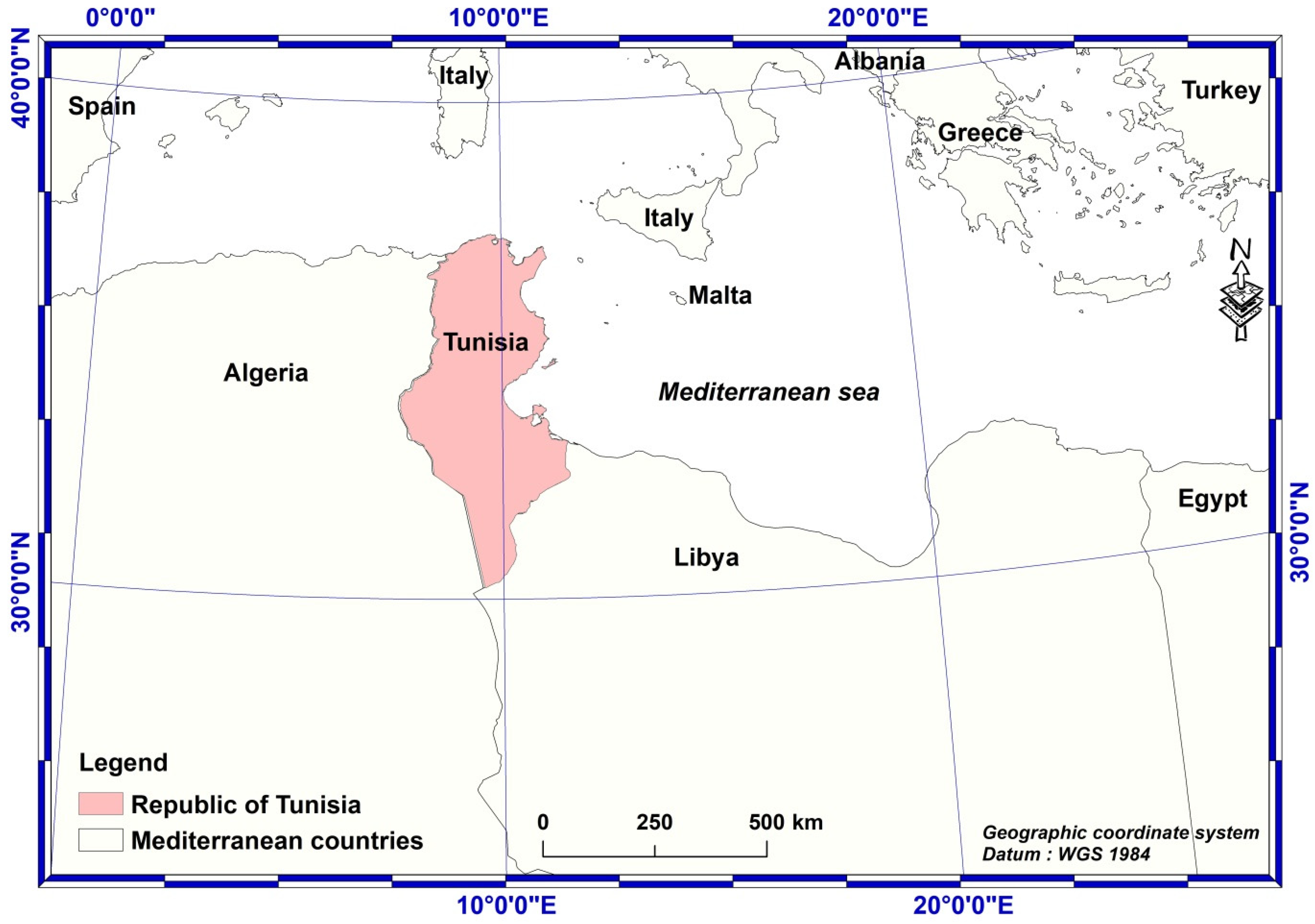

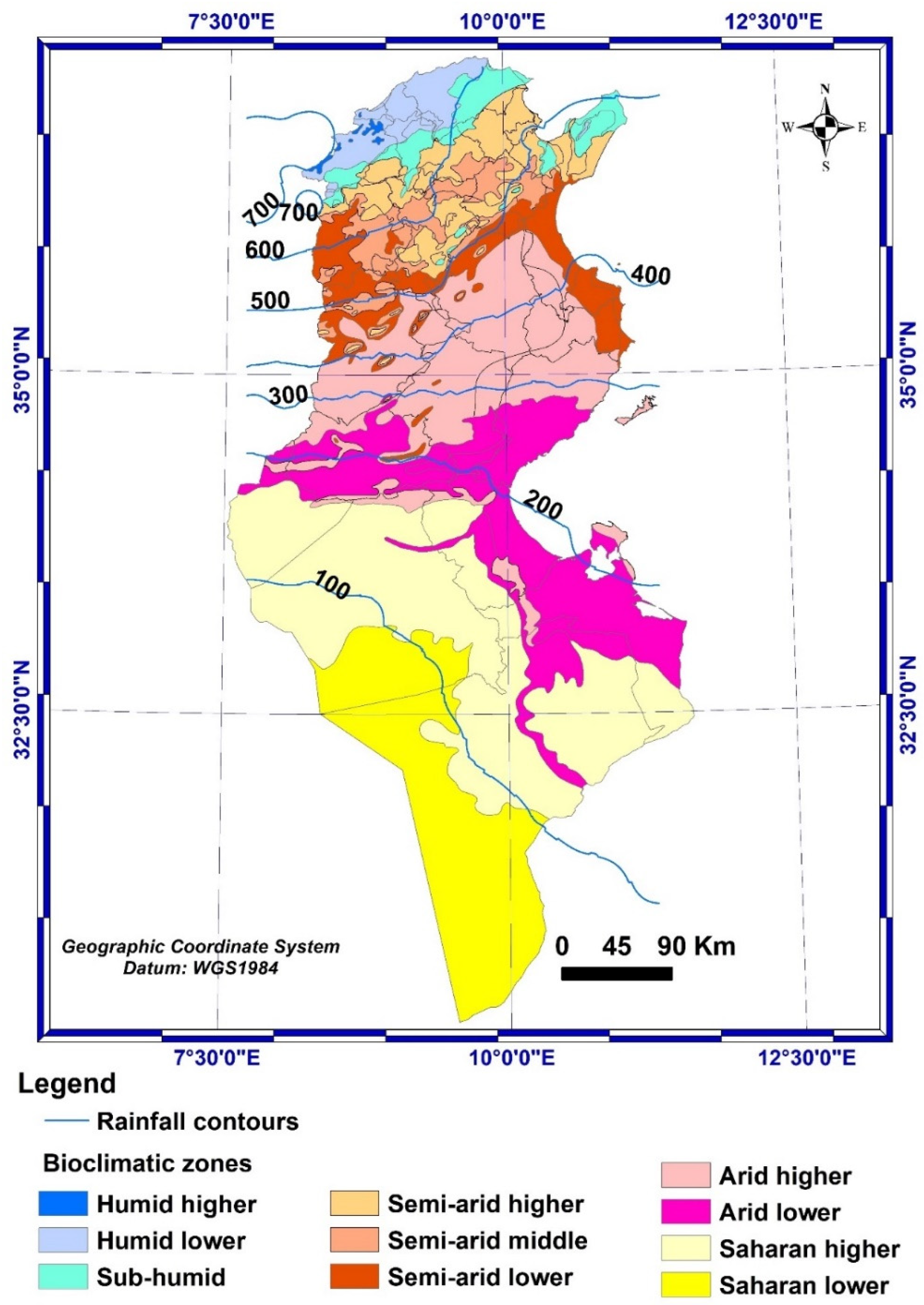
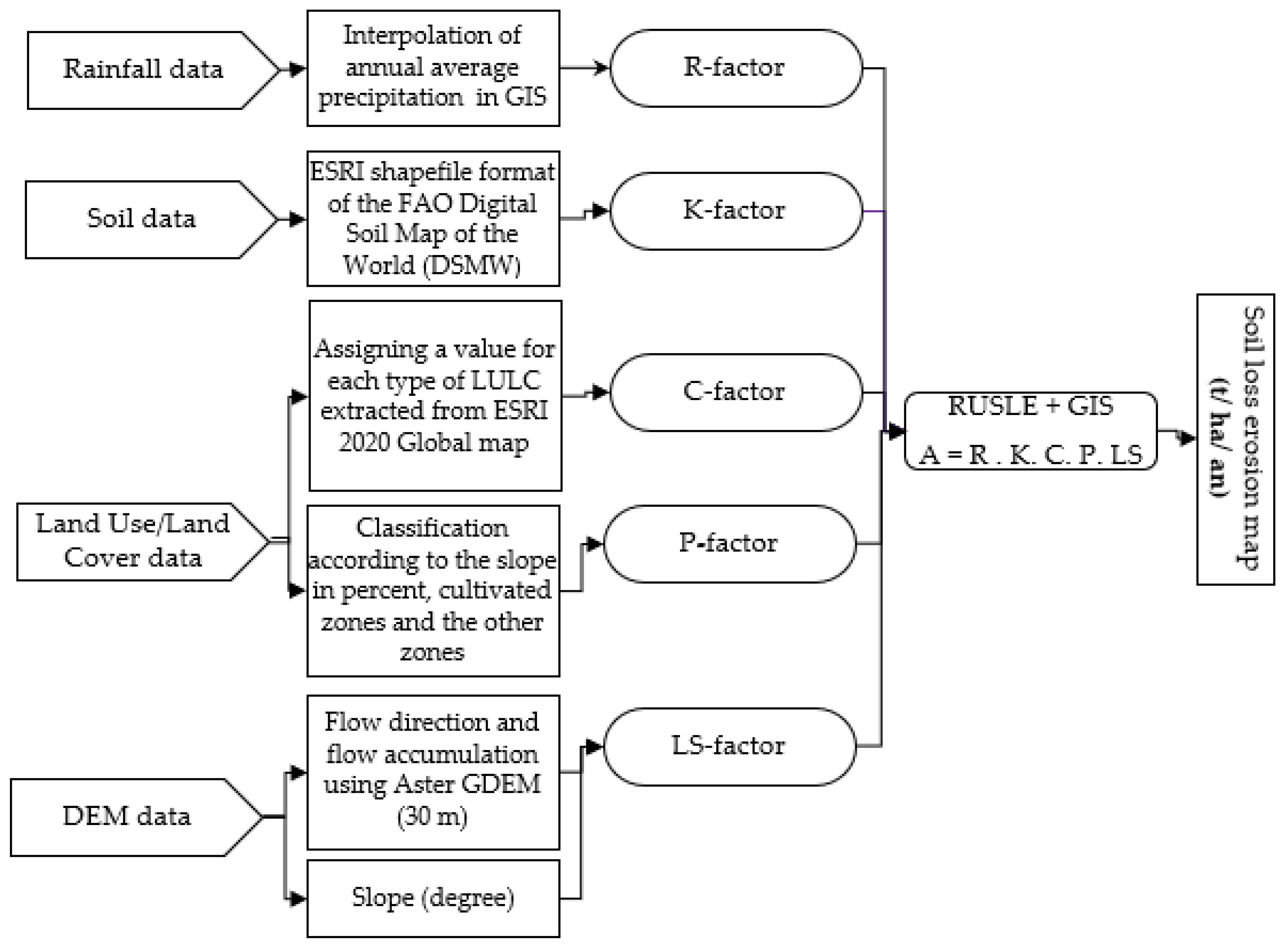
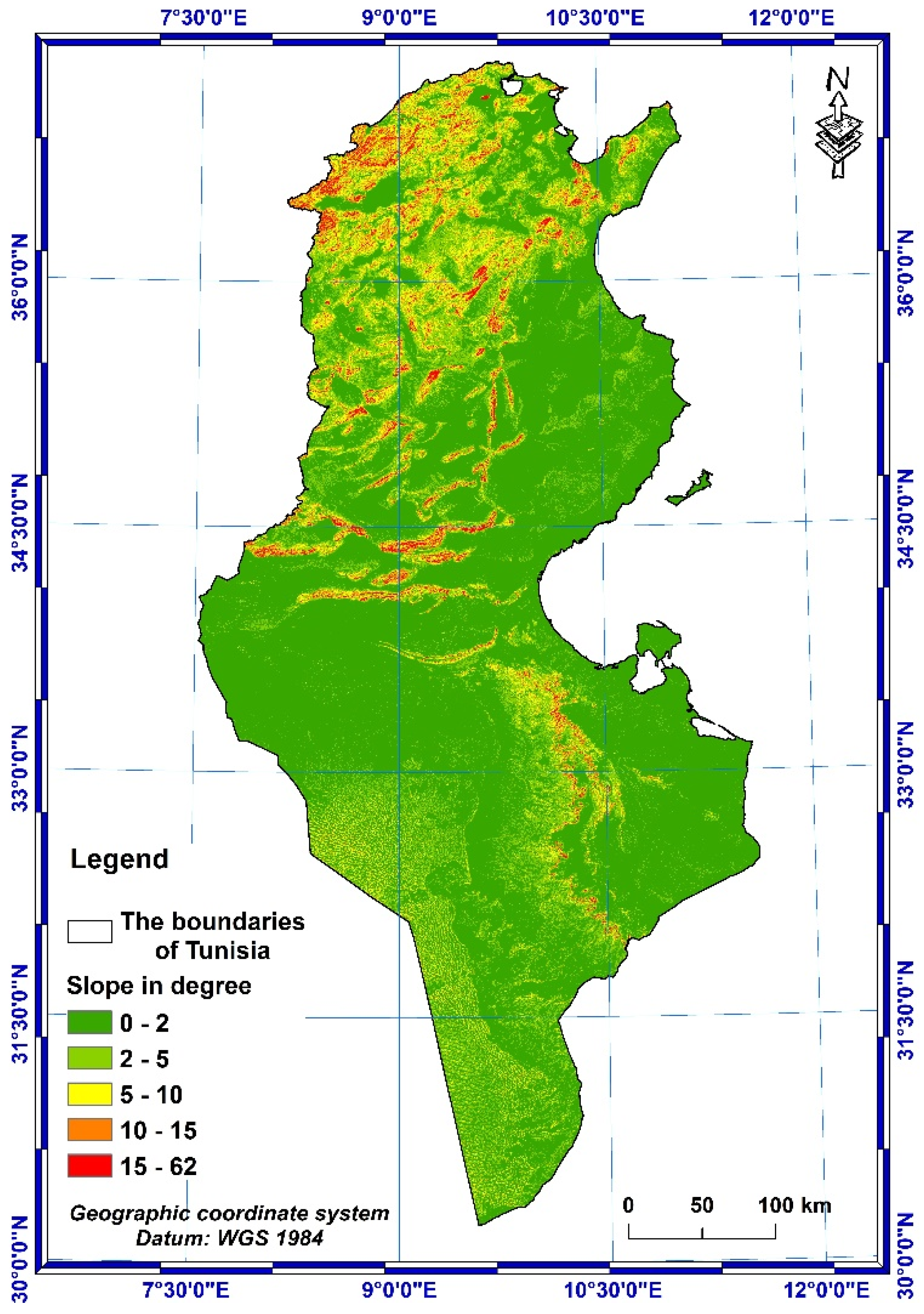
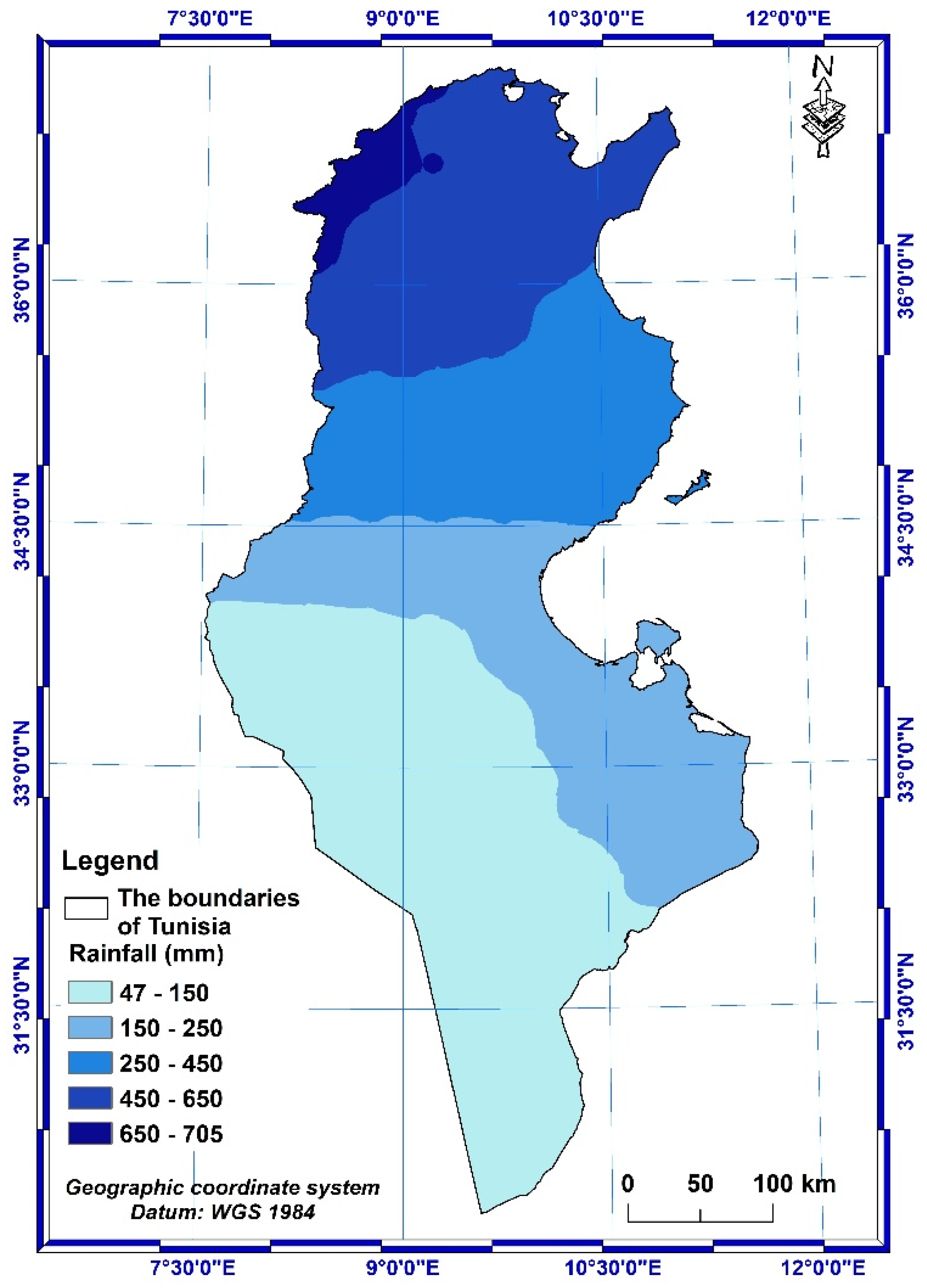
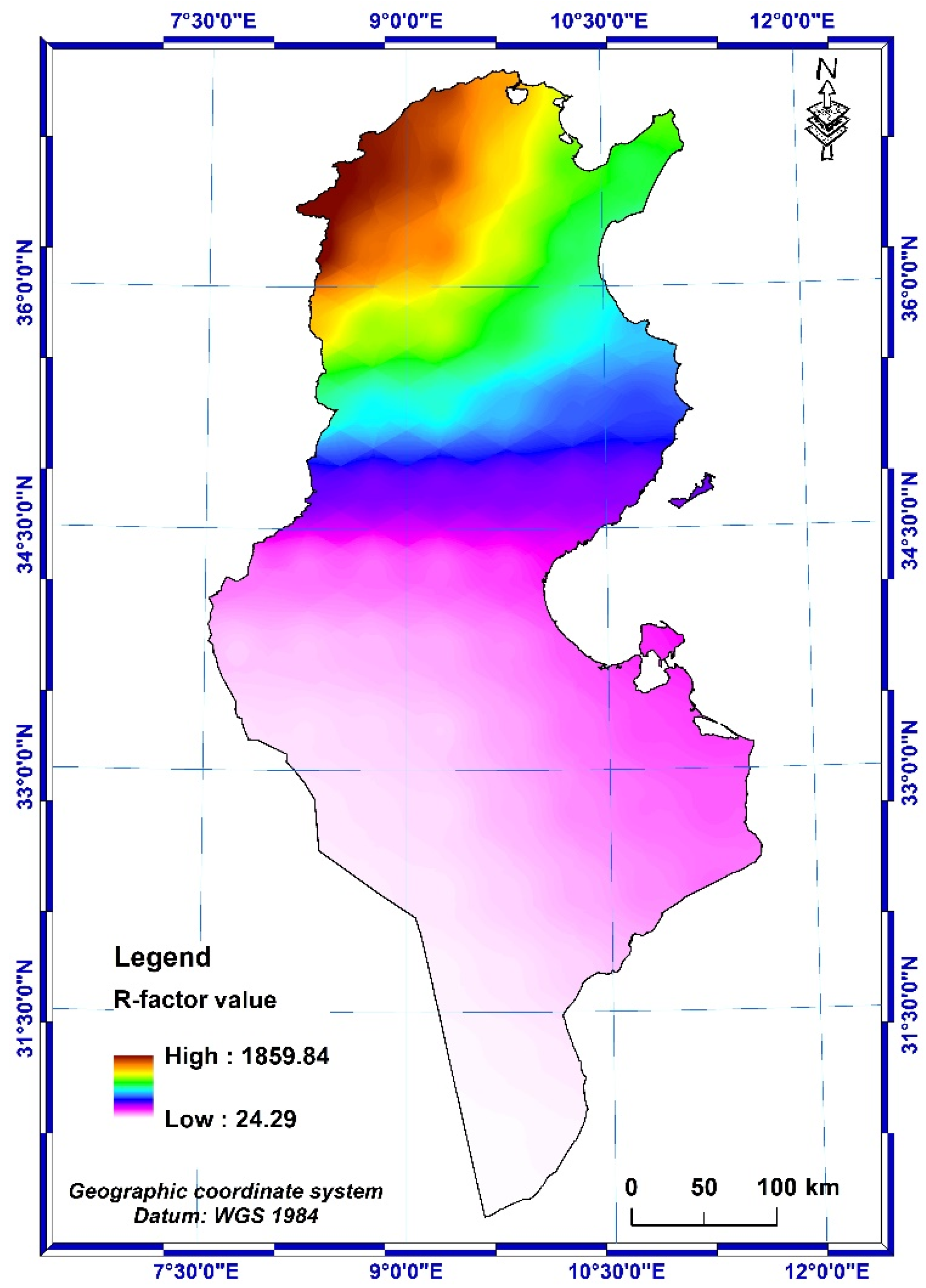
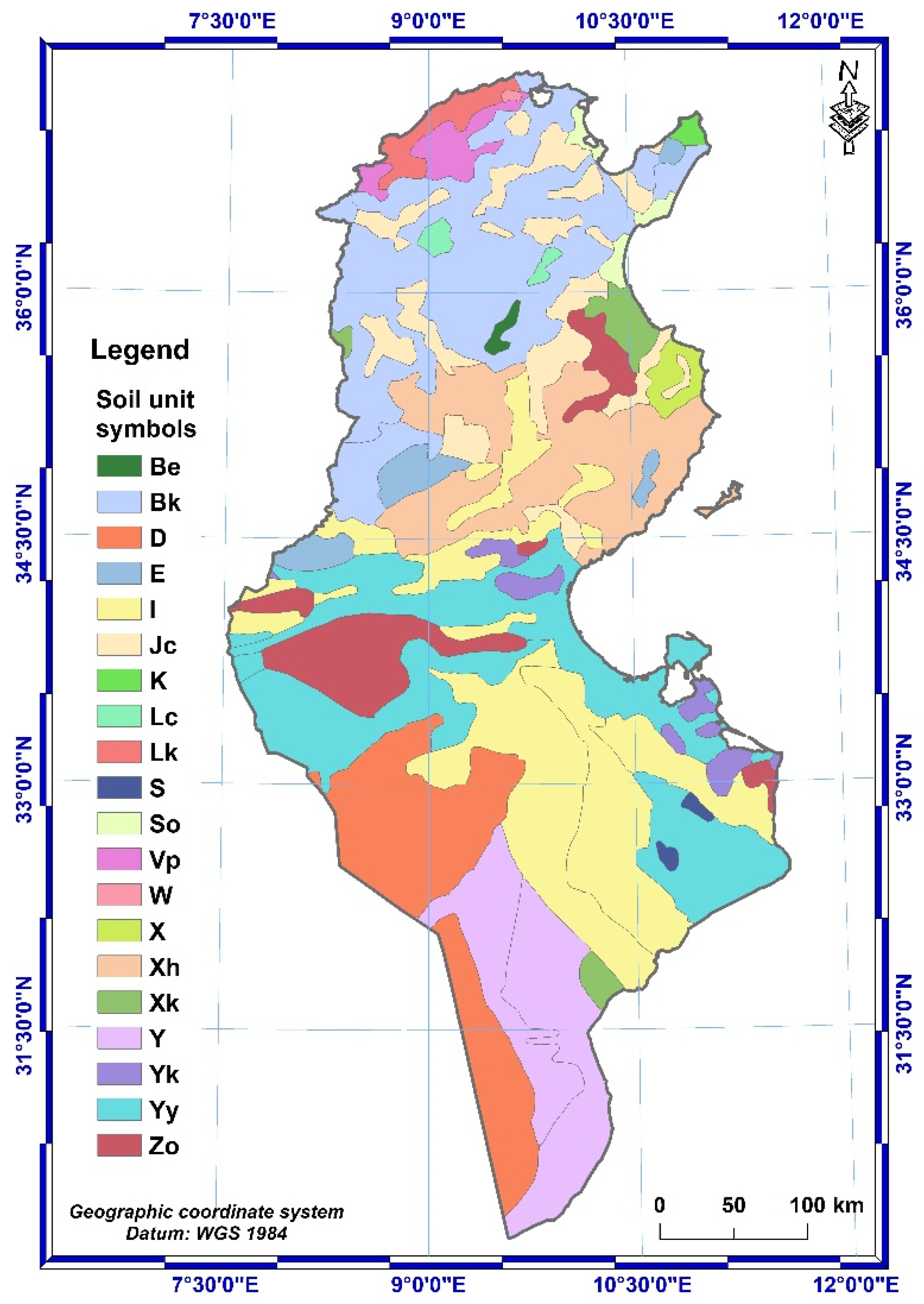
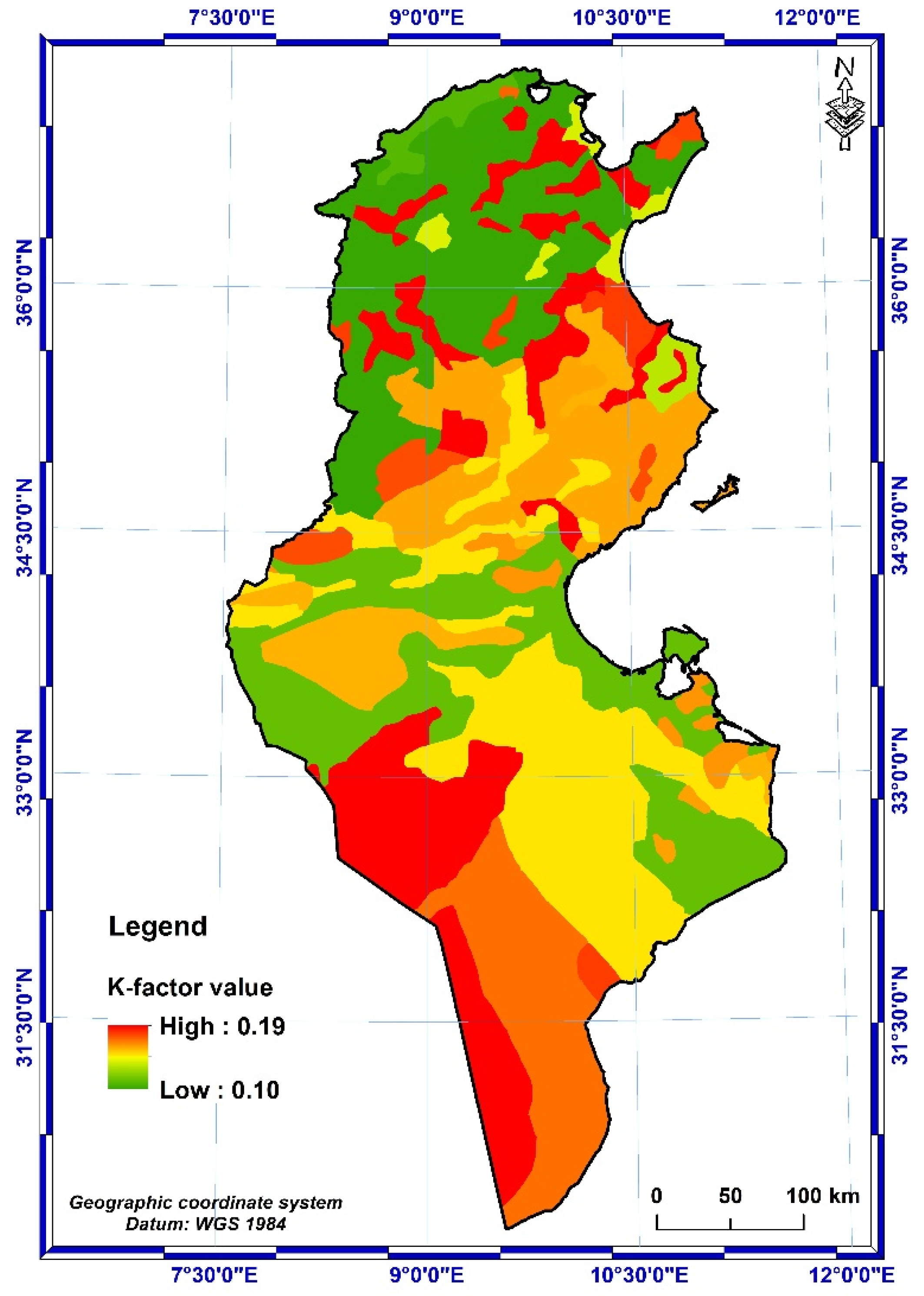
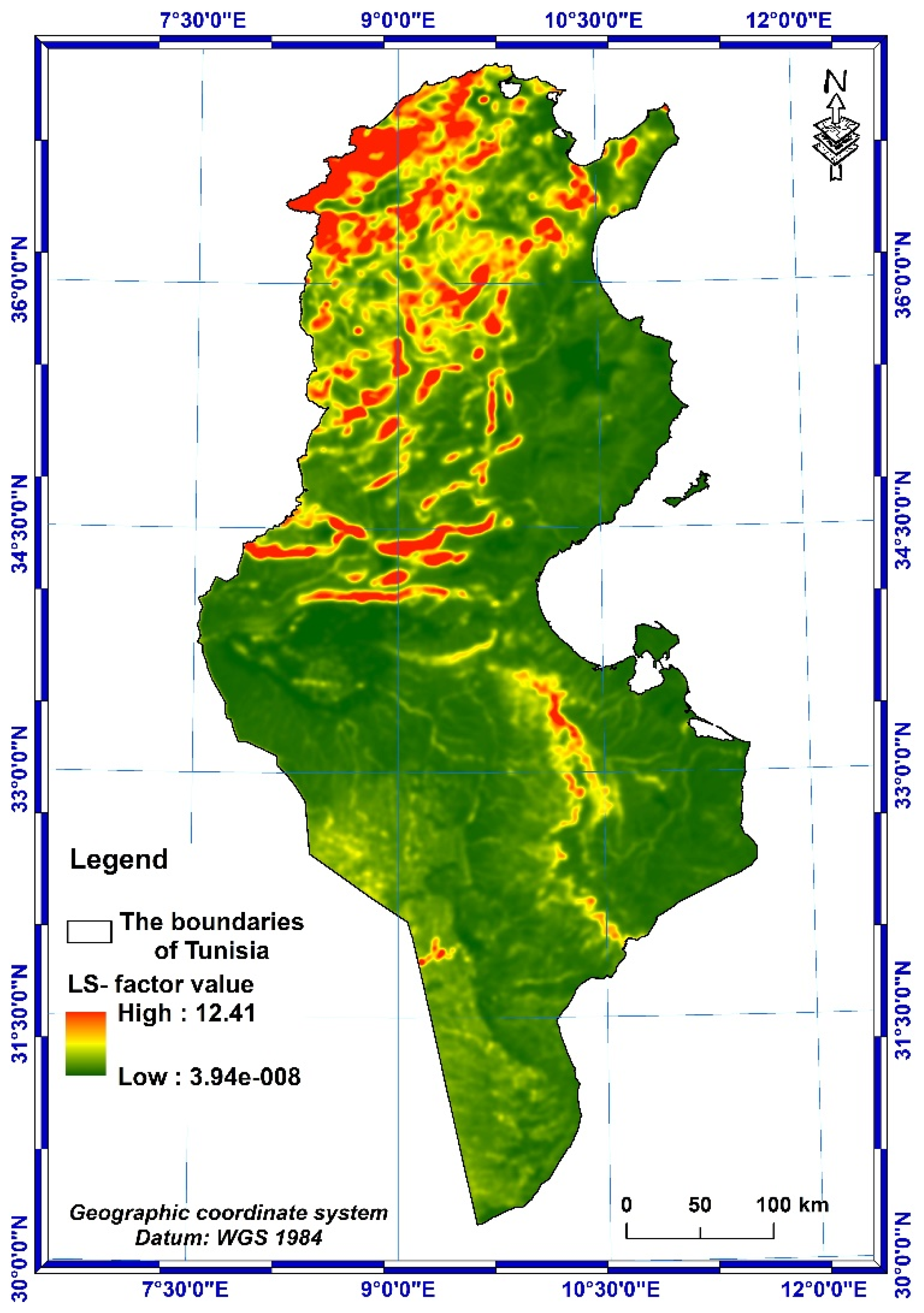
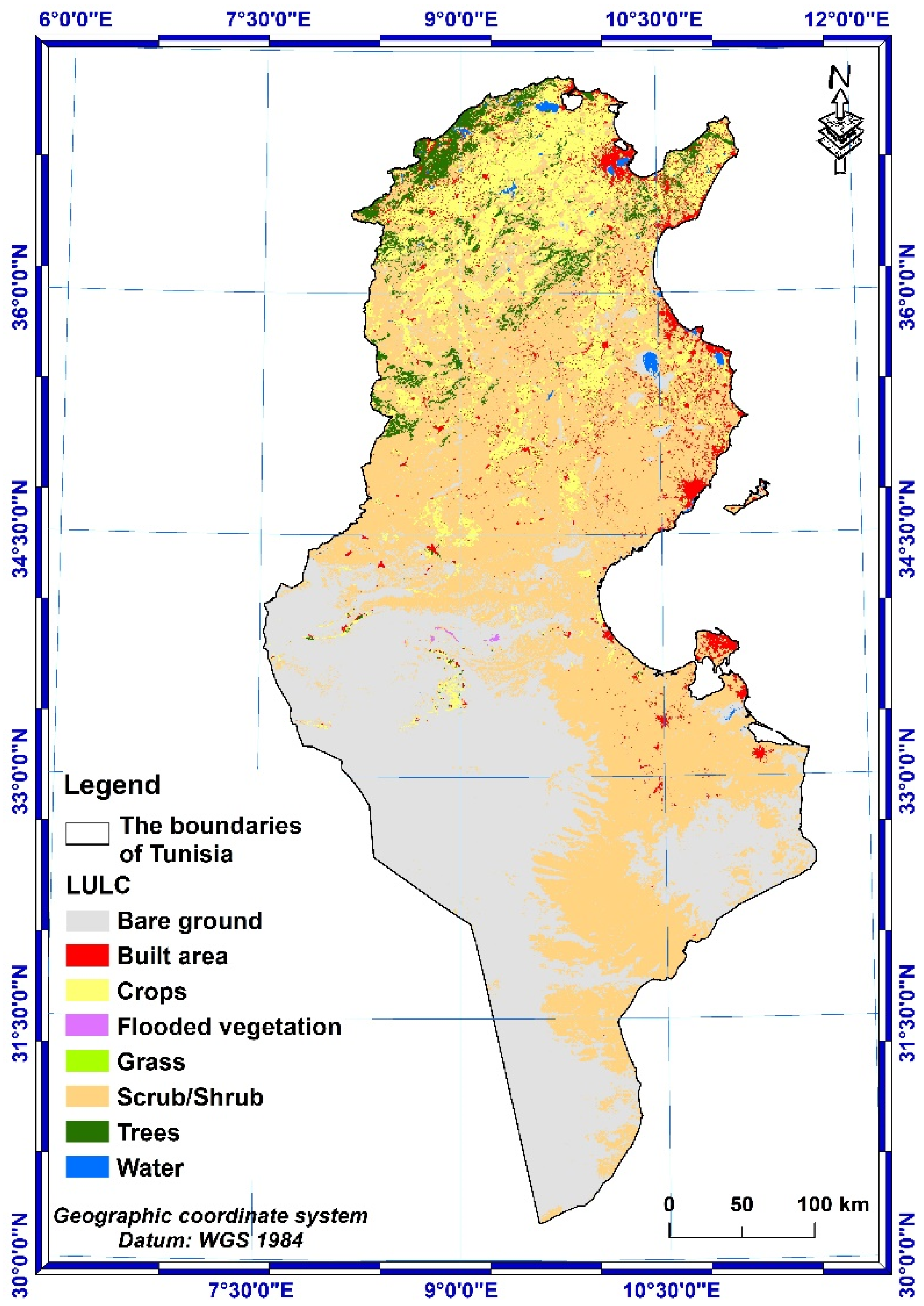

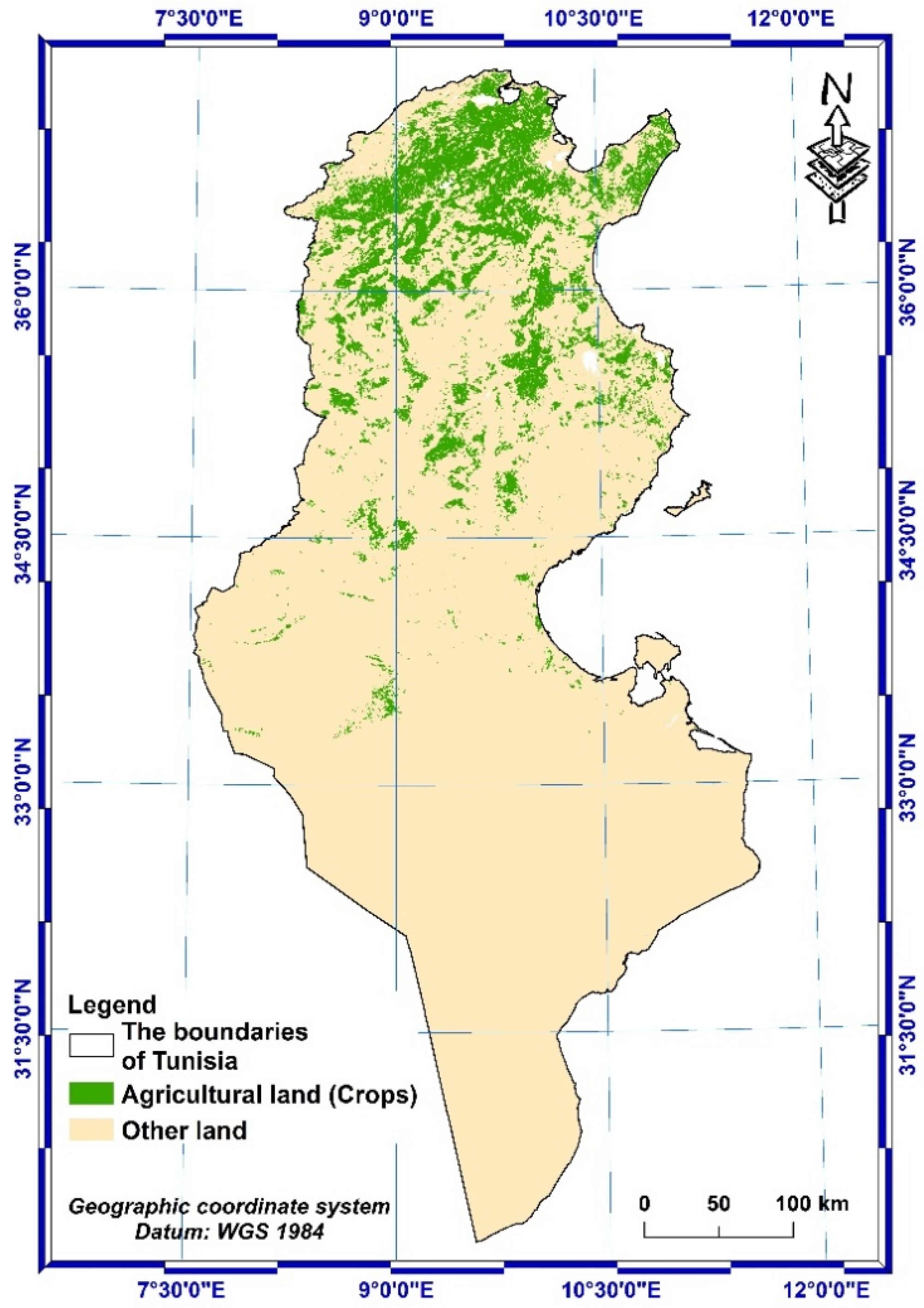

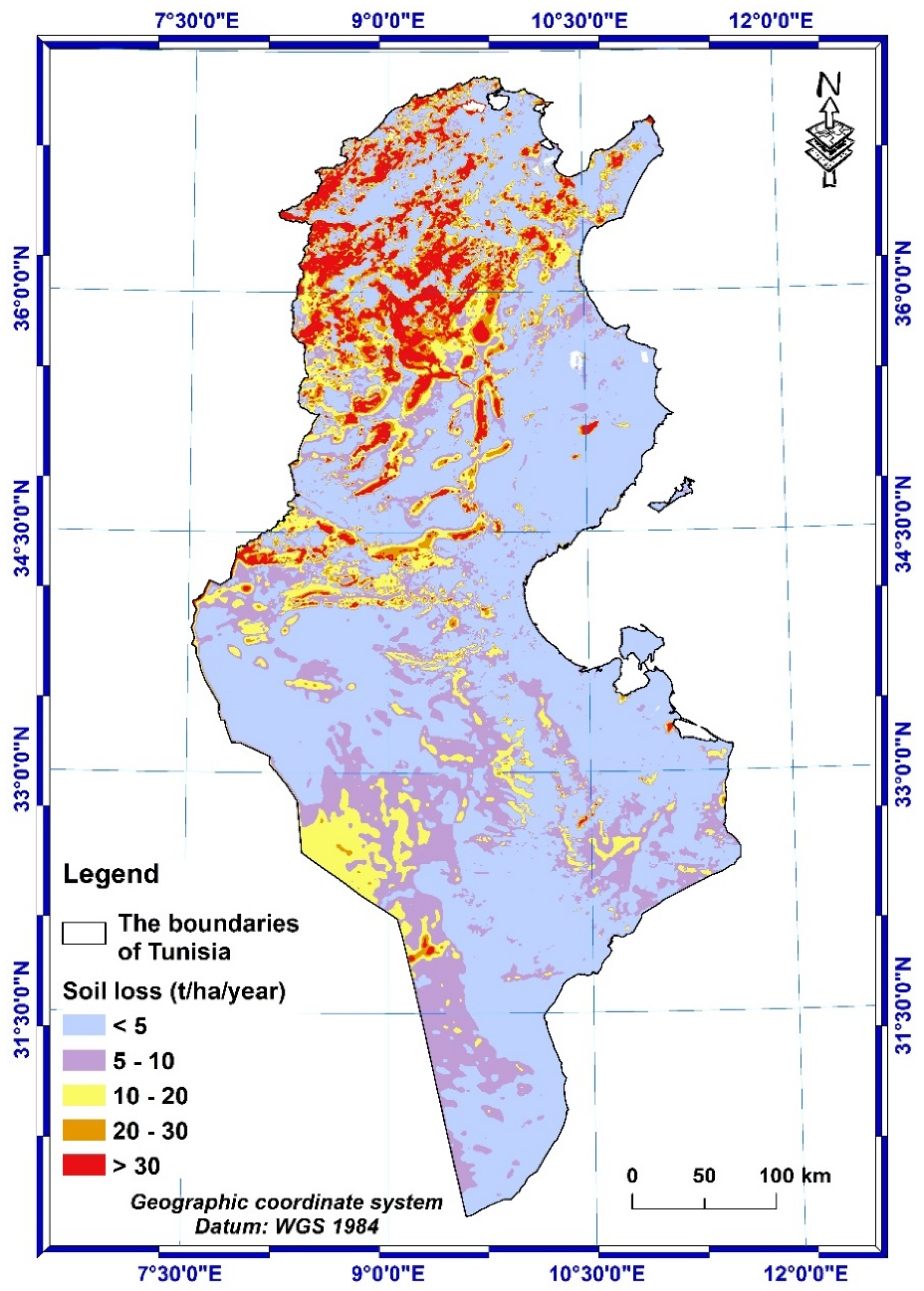
| Erodibility (K) | Type of Soil |
|---|---|
| K < 0.10 | Soil highly resistant to erosion |
| 0.10–0.25 | Soil fairly resistant to erosion |
| 0.25–0.35 | Soil moderately resistant to erosion |
| 0.35–0.45 | Soil with low erosion resistance |
| >0.45 | Soil with very low resistance to erosion |
| LULC Type | C-Factor | Source |
|---|---|---|
| Cropland | 0.24 | Guo et al., 2015 [65] |
| Forest (Dense) | 0.01 | Hurni, 1985 [66] |
| Grassland | 0.05 | Tiruneh and Ayalew, 2015 [67] |
| Shrubland | 0.2 | Tiruneh and Ayalew, 2015 [67] |
| Bare land | 0.6 | Ewunetu et al., 2021 [68] |
| Waterbody | 0 | Erdogan et al., 2006 [69]; Swarnkar el al., 2018 [70] |
| Settlement | 0.15 | Hurni, 1985 [66] |
| Slope (%) | P-Factor | |
|---|---|---|
| Agricultural land | 0–5 | 0.1 |
| 5–10 | 0.12 | |
| 10–20 | 0.14 | |
| 20–30 | 0.19 | |
| 30–50 | 0.25 | |
| 50–100 | 0.33 | |
| Other land | All | 1 |
| Score Scale | Soil Loss Class (t/ha/year) | Area (km2) | Area Percentage (%) | Indicator |
|---|---|---|---|---|
| 1 | <5 | 87,559.33 | 56.34 | Very low |
| 2 | 5–10 | 32,854.00 | 21.14 | Low |
| 3 | 10–20 | 18,471.60 | 11.89 | Moderate |
| 4 | 20–30 | 6535.03 | 4.21 | High |
| 5 | >30 | 9989.66 | 6.43 | Very high |
Disclaimer/Publisher’s Note: The statements, opinions and data contained in all publications are solely those of the individual author(s) and contributor(s) and not of MDPI and/or the editor(s). MDPI and/or the editor(s) disclaim responsibility for any injury to people or property resulting from any ideas, methods, instructions or products referred to in the content. |
© 2023 by the authors. Licensee MDPI, Basel, Switzerland. This article is an open access article distributed under the terms and conditions of the Creative Commons Attribution (CC BY) license (https://creativecommons.org/licenses/by/4.0/).
Share and Cite
Serbaji, M.M.; Bouaziz, M.; Weslati, O. Soil Water Erosion Modeling in Tunisia Using RUSLE and GIS Integrated Approaches and Geospatial Data. Land 2023, 12, 548. https://doi.org/10.3390/land12030548
Serbaji MM, Bouaziz M, Weslati O. Soil Water Erosion Modeling in Tunisia Using RUSLE and GIS Integrated Approaches and Geospatial Data. Land. 2023; 12(3):548. https://doi.org/10.3390/land12030548
Chicago/Turabian StyleSerbaji, Mohamed Moncef, Moncef Bouaziz, and Okba Weslati. 2023. "Soil Water Erosion Modeling in Tunisia Using RUSLE and GIS Integrated Approaches and Geospatial Data" Land 12, no. 3: 548. https://doi.org/10.3390/land12030548
APA StyleSerbaji, M. M., Bouaziz, M., & Weslati, O. (2023). Soil Water Erosion Modeling in Tunisia Using RUSLE and GIS Integrated Approaches and Geospatial Data. Land, 12(3), 548. https://doi.org/10.3390/land12030548







